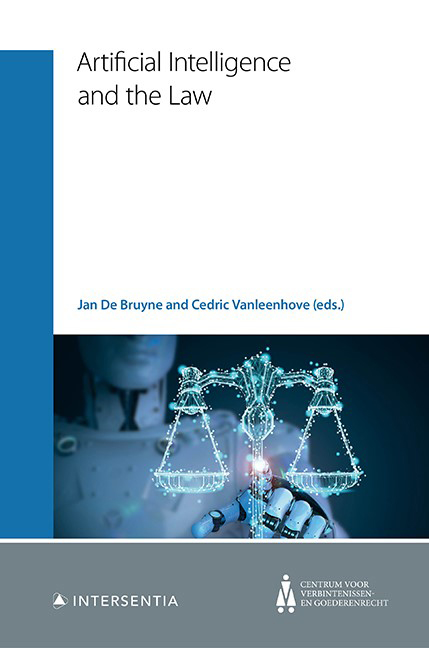Book contents
- Frontmatter
- Contents
- Foreword
- Contributing Authors
- Chapter 1 Basic Concepts of AI for Legal Scholars
- Chapter 2 Different Models of Innovation and Their Relation to Law
- Chapter 3 Setting the Scene: On AI Ethics and Regulation
- Chapter 4 Quantitative Legal Prediction: the Future of Dispute Resolution?
- Chapter 5 AI Arbitrators … ‘Does Not Compute’
- Chapter 6 AI through a Human Rights Lens. The Role of Human Rights in Fulfilling AI’s Potential
- Chapter 7 Killer Robots: Lethal Autonomous Weapons and International Law
- Chapter 8 AI and Data Protection: the Case of Smart Home Assistants
- Chapter 9 AI and IP: a Tale of Two Acronyms
- Chapter 10 Tax and Robots
- Chapter 11 Robotisation and Labour Law. The Dark Factory: the Dark Side of Work?
- Chapter 12 The Hypothesis of Technological Unemployment Caused by AI-Driven Automation and its Impact on Social Security Law
- Chapter 13 AI in Belgian Contract Law: Disruptive Challenge or Business as Usual?
- Chapter 14 Tort Law and Damage Caused by AI Systems
- Chapter 15 Insurance Underwriting on the Basis of Telematics: Segmentation and Profiling
- Chapter 16 AI and Creditworthiness Assessments: the Tale of Credit Scoring and Consumer Protection. A Story with a Happy Ending?
- Chapter 17 AI and the Consumer
- Chapter 18 Robots and AI in the Healthcare Sector: Potential Existing Legal Safeguards Against a(n) (Un)justified Fear for ‘Dehumanisation’ of the Physician-Patient Relationship
Chapter 12 - The Hypothesis of Technological Unemployment Caused by AI-Driven Automation and its Impact on Social Security Law
Published online by Cambridge University Press: 26 May 2021
- Frontmatter
- Contents
- Foreword
- Contributing Authors
- Chapter 1 Basic Concepts of AI for Legal Scholars
- Chapter 2 Different Models of Innovation and Their Relation to Law
- Chapter 3 Setting the Scene: On AI Ethics and Regulation
- Chapter 4 Quantitative Legal Prediction: the Future of Dispute Resolution?
- Chapter 5 AI Arbitrators … ‘Does Not Compute’
- Chapter 6 AI through a Human Rights Lens. The Role of Human Rights in Fulfilling AI’s Potential
- Chapter 7 Killer Robots: Lethal Autonomous Weapons and International Law
- Chapter 8 AI and Data Protection: the Case of Smart Home Assistants
- Chapter 9 AI and IP: a Tale of Two Acronyms
- Chapter 10 Tax and Robots
- Chapter 11 Robotisation and Labour Law. The Dark Factory: the Dark Side of Work?
- Chapter 12 The Hypothesis of Technological Unemployment Caused by AI-Driven Automation and its Impact on Social Security Law
- Chapter 13 AI in Belgian Contract Law: Disruptive Challenge or Business as Usual?
- Chapter 14 Tort Law and Damage Caused by AI Systems
- Chapter 15 Insurance Underwriting on the Basis of Telematics: Segmentation and Profiling
- Chapter 16 AI and Creditworthiness Assessments: the Tale of Credit Scoring and Consumer Protection. A Story with a Happy Ending?
- Chapter 17 AI and the Consumer
- Chapter 18 Robots and AI in the Healthcare Sector: Potential Existing Legal Safeguards Against a(n) (Un)justified Fear for ‘Dehumanisation’ of the Physician-Patient Relationship
Summary
INTRODUCTION
1. In this chapter we will examine the hypothesis of AI-driven automation, and the resulting technological unemployment and its impact on social security law. After briefly explaining, by way of several examples, what AI-driven automation entails (part 1), this chapter introduces the hypothesis of technological unemployment as a starting point for the analysis (part 2). Assuming this hypothesis is valid, this chapter then discusses its impact on social security law (part 3). In doing so, a distinction is made between employment as a structural feature of the design of social security legislation, and employment as the legitimation for the rights-based character of social security entitlements. Finally, this chapter concludes with the key message that this technological unemployment hypothesis demonstrates the vulnerability of our social security system to radical societal changes caused by technological advancement (part 4).
2. At the 2018 Google I/O conference Google CEO Sundar Pichai revealed Duplex, which is an extension of the Google Assistant application. It allows for the automation of conversations, with the presentation showcasing how the virtual assistant can autonomously complete calls such as booking a hairdresser's appointment or making reservations for a restaurant. It did so with notable ease, even if, when making reservations, the human on the other end of the line adds a factor of complexity by misunderstanding what is said. Remarkably, this virtual assistant makes the calls in a surprisingly human-like manner, incorporating several elements in its speech that make it difficult to distinguish from a real human, such as using filler words (‘um’ or ‘hmm’), adopting a human-like intonation, and introducing more response latency to make the conversation feel more natural. Google Duplex is but one of several examples of the recent popularisation of new technologies that involve natural language understanding, others being Amazon's Lex, IBM's Watson, or Apple's Siri. The commercial interest in these technologies is considerable, since they mean a new leap forward in automating tasks such as translation, content analysis, or reasoning. Customer service, an integral part of any organisation's operation, for example, represents a commercial area in which substantial efficiency gains could be made through the existence of intelligent chat bots that never tire, forget, or make errors, and are considerably cheaper than their human counterparts.
- Type
- Chapter
- Information
- Artificial Intelligence and the Law , pp. 317 - 334Publisher: IntersentiaPrint publication year: 2021

